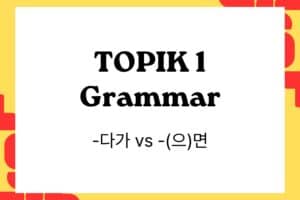Introduction Korean Grammar ‘-은/는 후에’ and ‘N후에’
Learning Korean grammar can be challenging, but breaking it down into manageable lessons can make it easier. Today, we will explore the grammar patterns ‘-은/는 후에’ and ‘N 후에,’ which are used to indicate actions or events that happen after another action or a specific time in Korean. This lesson will help you understand and use these forms effectively.
Learn Korean with JAEM : Improve your Korean with our app through free lessons and courses. And also, Join our 4-week challenge program to progress from upper-beginner to master level with Native Korean Coaches. Strat to study Korean more!
Our Book: Don’t miss out on our comprehensive book that covers essential Korean language skills and strategies. See our books and study with us! 🙂
AI Writing Practice Program: Enhance your writing skills with JAEM TOPIK, our AI-powered practice program. Get personalized feedback and TOPIK tips to elevate your Korean writing. Study TOPIK writing yourself and get high TOPIK score!

Jump to:
Grammar Explanation
-은/는 후에: The grammar pattern ‘-은/는 후에’ is used to indicate actions that happen after another action. It is similar to saying “after doing something” in English.
Formation:
- For verb stems ending in a consonant, add ‘-은 후에.’
- For verb stems ending in a vowel, add ‘-ㄴ 후에.’
| Speech Form | Form | Example Sentence |
|---|---|---|
| Verb (to go) | 간 후에 | 학교에 간 후에 (After going to school) |
| Verb (to eat) | 먹은 후에 | 밥을 먹은 후에 (After eating a meal) |
| Verb (to read) | 읽은 후에 | 책을 읽은 후에 (After reading a book) |
| Verb (to study) | 공부한 후에 | 공부한 후에 (After studying) |
N 후에: The pattern ‘N 후에’ is used to indicate a specific time after which an action or event happens. It is similar to saying “after a specific time” in English.
Formation:
- Attach ‘후에’ directly to a noun indicating a time.
| Speech Form | Form | Example Sentence |
|---|---|---|
| Noun (2 o’clock) | 2시 후에 | 2시 후에 (After 2 o’clock) |
| Noun (a year) | 1년 후에 | 1년 후에 (After a year) |
| Noun (a week) | 일주일 후에 | 일주일 후에 (After a week) |
| Noun (a month) | 한 달 후에 | 한 달 후에 (After a month) |
Examples
Using -은/는 후에:
- 가다 (to go)
- 간 후에 = After going
- 학교에 간 후에 숙제를 해요 = I do my homework after going to school.
- 먹다 (to eat)
- 먹은 후에 = After eating
- 밥을 먹은 후에 이를 닦아요 = I brush my teeth after eating a meal.
- 읽다 (to read)
- 읽은 후에 = After reading
- 책을 읽은 후에 잠을 자요 = I sleep after reading a book.
- 공부하다 (to study)
- 공부한 후에 = After studying
- 공부한 후에 친구를 만나요 = I meet my friend after studying.
Using N 후에:
- 2시 (2 o’clock)
- 2시 후에 = After 2 o’clock
- 2시 후에 집에 갈 거예요 = I will go home after 2 o’clock.
- 일주일 (a week)
- 일주일 후에 = After a week
- 일주일 후에 다시 만나요 = Let’s meet again after a week.
- 한 달 (a month)
- 한 달 후에 = After a month
- 한 달 후에 새로운 일을 시작할 거예요 = I will start a new job after a month.
- 1년 (a year)
- 1년 후에 = After a year
- 1년 후에 다시 한국에 갈 거예요 = I will go back to Korea after a year.
Comparison of -은/는 후에 and N 후에
-은/는 후에 is used to indicate actions that happen after another action:
- 학교에 간 후에 = After going to school
- 밥을 먹은 후에 = After eating a meal
- 책을 읽은 후에 = After reading a book
- 공부한 후에 = After studying
N 후에 is used to indicate a specific time after which an action or event happens:
- 2시 후에 = After 2 o’clock
- 일주일 후에 = After a week
- 한 달 후에 = After a month
- 1년 후에 = After a year
While ‘-은/는 후에’ is used with verbs to describe actions, ‘N 후에’ is used with nouns to describe a specific time or duration.
Common Mistakes
Common Mistakes:
- Incorrect: 간 후 (missing the final particle)
- Correct: 간 후에 = After going
- Incorrect: 2시 후 (missing the final particle)
- Correct: 2시 후에 = After 2 o’clock
Mistake Explanation: Ensure that the correct form ‘-은/는 후에’ is used for actions and ‘N 후에’ is used for specific times or durations.
Related Grammar Points
Explore these related grammar points to deepen your understanding:
- -기 전에: To express actions that happen before another action.
- -고 나서: To express actions that happen after another action.
- -을 때: To indicate the time when something happens.
- -면서: To indicate simultaneous actions.
Practice Exercises
Practice Makes Perfect!
- Exercise 1: Conjugate the following verbs using ‘-은/는 후에.’
- 가다 (to go)
- 먹다 (to eat)
- 읽다 (to read)
- 공부하다 (to study)
Answer Key:
- 간 후에
- 먹은 후에
- 읽은 후에
- 공부한 후에
- Exercise 2: Create sentences using ‘-은/는 후에’ for the following situations:
- After going to school
- After eating a meal
- After reading a book
- After studying at the library
Answer Key:
- 학교에 간 후에
- 밥을 먹은 후에
- 책을 읽은 후에
- 도서관에서 공부한 후에
- Exercise 3: Create sentences using ‘N 후에’ for the following situations:
- After 2 o’clock
- After a week
- After a month
- After a year
Answer Key:
- 2시 후에
- 일주일 후에
- 한 달 후에
- 1년 후에
Summary and Conclusion
Today, we covered the grammar points ‘-은/는 후에’ and ‘N 후에’ and how to use them to indicate actions or events that happen after another action or a specific time in Korean. These patterns are essential for providing context and clarity in conversations about daily activities and future plans. Continue practicing with our workbook and check out related lessons for more in-depth learning.
If you have any questions or suggestions, feel free to comment below. Happy learning!
Learn Real Korean with JAEM!
Learn Korean with JAEM Korean App & JAEM Challenge: Discover the best way to learn real Korean with our comprehensive app. Enjoy a wide variety of free lessons and courses designed to help you master the language. Also, our unique JAEM challenge program guides you from an upper-beginner level to a master course, all under the guidance of Native Korean Coaches. Whether you’re just starting out or looking to refine your skills, this program offers an effective path to fluency.
AI Korean Writing Practice Program: Take your Korean writing to the next level with JAEM TOPIK, our innovative AI writing practice program. This service provides personalized feedback and practical tips tailored to your learning needs. With a focus on improving your Korean writing, JAEM TOPIK also offers specific strategies for excelling in the TOPIK exam. Benefit from expert insights and targeted advice to enhance your proficiency and confidence in writing.
Our Book: Additionally, explore our comprehensive book that covers essential Korean language skills and strategies. This valuable resource complements our app and AI program, providing a holistic approach to mastering Korean.



















Responses